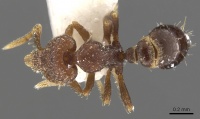Strumigenys tethys
| Strumigenys tethys | |
|---|---|

| |
| Scientific classification | |
| Kingdom: | Animalia |
| Phylum: | Arthropoda |
| Class: | Insecta |
| Order: | Hymenoptera |
| Family: | Formicidae |
| Subfamily: | Myrmicinae |
| Tribe: | Attini |
| Genus: | Strumigenys |
| Species: | S. tethys |
| Binomial name | |
| Strumigenys tethys (Bolton, 2000) | |
This species has been found in rainforest litter-samples.
Identification
Bolton (2000) - A member of the Strumigenys capitata-group. Within the group tethys belongs to a complex of small to minute species (HW 0.50 or less), with a mostly to entirely smooth postpetiole disc, that also includes Strumigenys charybdis, Strumigenys epipola, Strumigenys phasma and Strumigenys themis. Apart from their small size these five species have the apicoscrobal and pronotal humeral hairs stout and blunted to weakly remiform or clavate apically. Of the five tethys is immediately characterised by the costulate sculpture on the lateral alitrunk and extremely reduced ventral spongiform strip on the petiole.
Keys including this Species
Distribution
Distribution based on Regional Taxon Lists
Indo-Australian Region: New Guinea (type locality).
Distribution based on AntMaps
Distribution based on AntWeb specimens
Check data from AntWeb
Countries Occupied
| Number of countries occupied by this species based on AntWiki Regional Taxon Lists. In general, fewer countries occupied indicates a narrower range, while more countries indicates a more widespread species. |

|
Estimated Abundance
| Relative abundance based on number of AntMaps records per species (this species within the purple bar). Fewer records (to the left) indicates a less abundant/encountered species while more records (to the right) indicates more abundant/encountered species. |

|
Biology
Castes
Nomenclature
The following information is derived from Barry Bolton's Online Catalogue of the Ants of the World.
- tethys. Pyramica tethys Bolton, 2000: 406 (w.) NEW GUINEA. Combination in Strumigenys: Baroni Urbani & De Andrade, 2007: 129
Unless otherwise noted the text for the remainder of this section is reported from the publication that includes the original description.
Description
Worker
Holotype. TL 1.9, HL 0.52, HW 0.42, CI 80, ML 0.11, MI 21, SL 0.24, SI 57, PW 0.28, AL 0.48. Apicoscrobal and pronotal humeral hairs more or less straight, blunted to weakly remiform apically. Dorsum of head with a transverse row of 4 standing hairs close to the occipital margin, and with a pair of similar hairs just in front of the highest point of the vertex. Eye with 4 ommatidia in the longest row. Reticulate-punctate sculpture of cephalic dorsum fine and dense, almost granulate. Dorsal alitrunk finely reticulate-punctate as head. In profile side of pronotum with fine oblique costulate sculpture, not reticulate-punctate. Katepisternum smooth and shining, remainder of side of alitrunk shallowly longitudinally costulate and with some weak punctures. Mesonotum with a single pair of stout standing hairs dorsally. Similar but somewhat shorter hairs also present on dorsum of petiole node (1 pair), disc of postpetiole (3 pairs) and first gastral tergite where they are numerous. Ventral spongiform strip of petiole reduced to a carina-like vestige below peduncle. In profile the height of the anterior face of the petiole node greater than the length of its dorsum (excluding the posterior collar). Lateral spongiform lobe of petiole very small, reduced to a narrow flange at the termination of the posterior collar. In dorsal view the petiole node disc nearly twice broader than long (length 0.08, width 0.14), roughly transversely rectangular in outline. Disc of postpetiole in dorsal view large and very broad, twice broader than long (length 0.12, width 0.25), smooth and shining dorsally but with vestiges of sculpture on the sides.
Paratypes. TL 1.8-2.0, HL 0.50-0.52, HW 0.40-0.42, CI 78-82, ML 0.11-0.12, MI 21-24, SL 0.22-0.24, SI 54-60, PW 0.27-0.30, AL 0.48-0.51 (7 measured). As holotype but eye with 3-4 ommatidia in longest row. On side of alitrunk all specimens have the metapleuron and propodeum distinctly finely longitudinally costulate, but in some there may also be fine punctures between the costulate component.
Type Material
Holotype worker, Papua New Guinea: C. P., Varirata N.P., 550 m., 5.ii.1981 (W. L. Brown) (Museum of Comparative Zoology).
Paratypes. 7 workers with same data as holotype (MCZ, The Natural History Museum).
References
- Baroni Urbani, C. & De Andrade, M.L. 2007. The ant tribe Dacetini: limits and constituent genera, with descriptions of new species. Annali del Museo Civico di Storia Naturale “G. Doria” 99:1-191.
- Bolton, B. 2000. The ant tribe Dacetini. Memoirs of the American Entomological Institute. 65:1-1028. (page 406, worker described)
References based on Global Ant Biodiversity Informatics
- Bolton, B. 2000. The Ant Tribe Dacetini. Memoirs of the American Entomological Institute 65
- CSIRO Collection
- Janda M., G. D. Alpert, M. L. Borowiec, E. P. Economo, P. Klimes, E. Sarnat, and S. O. Shattuck. 2011. Cheklist of ants described and recorded from New Guinea and associated islands. Available on http://www.newguineants.org/. Accessed on 24th Feb. 2011.

